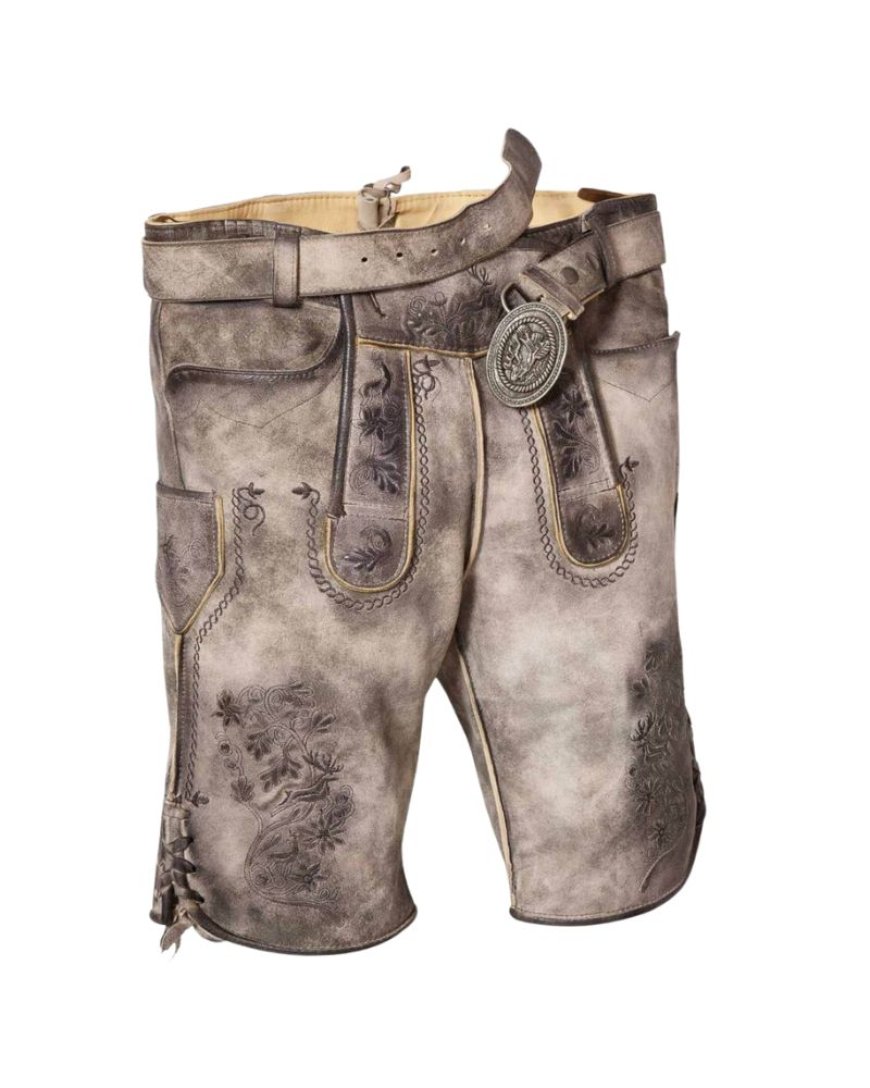What Are Lederhosen Made From? Leather Types Explained
Curious what lederhosen are made of? Discover the different leather types, quality tips, and how to choose the right material for comfort, durability, and tradition.

What Are Lederhosen Made From? Leather Types Explained
Lederhosen have been an iconic part of Bavarian and Alpine tradition for centuries. These classic leather breeches were originally designed for hard labor, thanks to their durable, practical material. But today, theyve become a stylish cultural symbol especially during Oktoberfest and folk events. If youre wondering what gives lederhosen their signature look and long-lasting quality, it all comes down to the type of leather used.
In this detailed guide, well walk you through the most common types of leather used in lederhosen, how they differ, and which one may be best for you. Whether you're a first-time buyer or looking to upgrade your pair, this guide will help you make an informed choice.
1. Why Leather Matters in Traditional Lederhosen
Leather isnt just about aesthetics it defines the comfort, durability, and authenticity of lederhosen. Traditional pieces were made to endure daily wear from farmers and laborers, which is why only the toughest leathers were chosen. Today, the tradition continues, but leather is also chosen for its luxurious feel, flexibility, and natural finish. Whether soft or rugged, the leather makes all the difference.
2. Deerskin Leather (Rehleder) Soft & Luxurious
Deerskin leather, also known as "Rehleder," is one of the finest materials used in premium lederhosen. Its ultra-soft, breathable, and molds comfortably to the body over time. Deerskin offers a smooth, velvety texture and ages beautifully with proper care. These lederhosen tend to be more expensive but are often considered the most comfortable and traditional option.
A great example of high-quality craftsmanship using this leather is found in the Augsburg aged deerskin style a classic piece that reflects both heritage and elegance.
3. Goatskin Leather (Ziegenleder) Durable & Affordable
Goatskin is a practical choice for those seeking durability without sacrificing too much softness. Its slightly stiffer than deerskin but still supple and comfortable for long wear. Goatskin lederhosen are generally more affordable and easier to maintain, making them ideal for first-time buyers or those who plan to wear them occasionally.
The texture is more pronounced, offering a rustic appeal. Its also more resistant to scratches and outdoor wear, which suits festival-goers who expect a little dirt and beer now and then!
4. Cowhide Leather (Rindsleder) Rugged & Traditional
Cowhide is the most robust and heavy-duty leather type used in lederhosen. Its stiffer and takes longer to break in but offers incredible strength and durability. Cowhide lederhosen are often used in rural regions and working environments, maintaining the garments original purpose.
They have a rougher surface and are heavier in weight, which means they stay firm and structured for years. For those looking to preserve the old-world look, cowhide is a solid choice.
5. Suede Finish (Veloursleder) A Modern Twist
Many modern lederhosen come in suede finishes for a more casual or fashion-forward look. Suede is often made from split leather the inner layer of animal hide. Its lightweight, soft, and easier to dye in various colors, from traditional browns and grays to vibrant shades like forest green or burgundy.
Suede lederhosen are often chosen for casual Oktoberfest looks or themed parties where full tradition isnt required. However, suede is more prone to stains, so be sure to treat it carefully.
6. Polished Leather (Glattleder) Sleek & Stylish
Polished leather adds a sleek and shiny finish to lederhosen, ideal for more formal events or upscale celebrations. These are less traditional but increasingly popular in fashion-forward Bavarian outfits. The smooth surface is easy to clean but can be less breathable than natural leathers.
Perfect for evening events or as part of modern attire, polished leather adds flair to your ensemble without losing its roots.
7. How Leather Quality Affects Comfort
Soft leathers like deerskin conform better to the body, offering unmatched comfort, while tougher leathers may feel rigid at first but provide long-term durability. Consider your use: If youre dancing, walking, or sitting for long hours, opt for flexible leathers. On the other hand, for costume purposes or rugged use, stiffer leathers work just fine.
A well-made pair should feel snug but not tight much like a tailored jacket that breaks in over time.
8. Color & Grain The Beauty of Natural Variation
Each leather type comes with unique markings and grains. No two pieces of lederhosen will look exactly the same, and thats part of their charm. Natural marks, color gradients, and textures add personality to every pair. Traditional browns and grays are most common, but dyed versions are available for fashion flexibility.
Keep in mind that dyed leather may fade with time, while natural-toned leather darkens and shines with age adding to its character.
9. How to Identify Authentic Leather
Check the inside of the lederhosen real leather will often have an unfinished surface on the inside. Genuine pieces will also have a slight, natural scent and uneven grain patterns. Synthetic or imitation leather may look too uniform or plasticky and wont mold to your body the same way.
Trusted sellers will always list the type of leather used, so dont hesitate to ask or look at product descriptions closely.
10. How to Style Your Lederhosen According to the Leather
Different leathers match different styles. For example, rugged cowhide pairs well with traditional shirts and rustic accessories. Suede finishes go well with modern, slim-cut shirts or embroidered suspenders. For ideas on how to put together a complete outfit, this styling guide offers excellent inspiration for combining pieces tastefully.
11. Price Guide: What to Expect Based on Leather
Prices vary based on the type of leather:
-
Deerskin: 250600+
-
Goatskin: 150300
-
Cowhide: 180400
-
Suede/Polished: 100250
Always match your budget with your usage expectations. Spending more on deerskin makes sense if you plan to wear it regularly or keep it for years.
12. Caring for Each Leather Type
Leather is a natural material that requires regular care:
-
Deerskin: Use gentle leather cleaner and keep away from direct heat.
-
Goatskin/Cowhide: Wipe with damp cloth and condition with leather balm.
-
Suede: Use suede brushes and avoid water exposure.
Always store your lederhosen in a cool, dry place. Avoid plastic covers leather needs to breathe.
13. How Leather Changes Over Time
Leather naturally darkens, softens, and gains a unique patina with use. Thats what makes it so special. High-quality lederhosen often look even better after years of wear. Over time, it becomes a personal item full of memories, marks, and character from every event.
Proper care helps it age gracefully, so take a few minutes after each wear to clean and store them correctly.
14. Where to Shop for Quality Lederhosen
Always buy from trusted retailers that specialize in Bavarian fashion. Avoid costume shops or overly cheap pieces that use synthetic leather. A reliable source like TheLederhoseHerren.de offers high-quality options with detailed descriptions and heritage craftsmanship ideal for those looking for authenticity and comfort.
15. Final Thoughts: Invest in Leather That Tells a Story
Lederhosen are more than just clothes theyre a celebration of culture, history, and personal style. Choosing the right leather sets the foundation for years of wear and enjoyment. Whether you prefer rugged cowhide or soft deerskin, make your decision based on comfort, style, and tradition. And remember, good leather gets better with age.
FAQs
Q1. Whats the softest leather for lederhosen?
Deerskin is the softest and most luxurious, ideal for comfort and frequent wear.
Q2. Is suede real leather?
Yes, suede is a form of split leather its real but more delicate than full-grain types.
Q3. Are synthetic lederhosen worth buying?
Not for traditional use. They may look the part but lack durability, breathability, and cultural value.
Q4. How can I tell if lederhosen are real leather?
Look for natural textures, scents, and uneven grain. Real leather will also feel breathable and flexible.
Q5. Does leather shrink or stretch over time?
Most leathers stretch slightly with wear, especially deerskin and goatskin. Cowhide stays more rigid.
Q6. Can I wear lederhosen in hot weather?
Yes, especially if made from lightweight leathers like deerskin or suede. Avoid heavy cowhide in high heat.








































